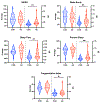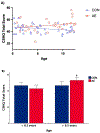Characteristics of sleep in children with heavy prenatal alcohol exposure
- PMID: 38523054
- PMCID: PMC11073897
- DOI: 10.1111/acer.15303
Characteristics of sleep in children with heavy prenatal alcohol exposure
Abstract
Background: Sleep plays an important role in neurodevelopment. However, the effects of prenatal alcohol exposure on sleep quality have been understudied, despite reports of sleep disturbance in infants prenatally exposed to alcohol and elevated levels of sleep problems reported by caregivers of children with fetal alcohol spectrum disorders. The current study characterizes sleep in children with prenatal alcohol exposure using both objective (actigraphy) and subjective (questionnaires, sleep diaries) methods.
Methods: Participants aged 6-10 years, with and without prenatal alcohol exposure, were included in the study (alcohol-exposed [AE]: n = 35; control [CON]: n = 39). Objective sleep was measured via 24-h actigraphy for 2 weeks. Parents completed sleep diaries and sleep questionnaires (Children's Sleep Habits Questionnaire, Pediatric Sleep Questionnaire). Multivariate analysis of variance was used to characterize the sleep profile (objective, subjective) and examine group differences.
Results: There were no group differences on actigraphy metrics averaged across 2 weeks. However, the AE group showed significantly greater intraindividual variability on most actigraphy measures, particularly total sleep time, percent sleep, wake after sleep onset, and number of wake bouts. Parents reported significantly more sleep problems in the AE group than in the CON group, primarily driven by night wakings, parasomnias (e.g., sleepwalking), snoring, and daytime sleepiness. These effects were more severe in children >8.5 years of age.
Conclusions: Despite similar 2-week average sleep outcomes, children with prenatal alcohol exposure showed greater intraindividual sleep variability and parents reported more sleep problems related to sleep behavior and snoring. These difficulties with sleep may be related to other cognitive and behavioral outcomes. Importantly, sleep is a modifiable behavior, and interventions that focus on variability in sleep, particularly in sleep duration, can impact the quality of life in children with prenatal alcohol exposure and their families.
Keywords: actigraphy; fetal alcohol spectrum disorder; intraindividual variability; prenatal alcohol exposure; sleep.
© 2024 The Authors. Alcohol, Clinical and Experimental Research published by Wiley Periodicals LLC on behalf of Research Society on Alcohol.
Figures




Similar articles
-
Actigraphy-measured sleep concordance, night-wakings, intraindividual sleep variability in parents and their children-Associations with childhood sleep disturbances.J Sleep Res. 2023 Jun;32(3):e13773. doi: 10.1111/jsr.13773. Epub 2022 Nov 7. J Sleep Res. 2023. PMID: 36345126
-
Sleep and sensory characteristics in young children with fetal alcohol spectrum disorder.J Dev Behav Pediatr. 2011 Jun;32(5):384-92. doi: 10.1097/DBP.0b013e3182199694. J Dev Behav Pediatr. 2011. PMID: 21654404
-
Correspondence of parent report and laboratory measures of inattention and hyperactivity in children with heavy prenatal alcohol exposure.Neurotoxicol Teratol. 2014 Mar-Apr;42:43-50. doi: 10.1016/j.ntt.2014.01.007. Epub 2014 Feb 7. Neurotoxicol Teratol. 2014. PMID: 24512965 Free PMC article.
-
Sleep in Infants and Children with Prenatal Alcohol Exposure.Alcohol Clin Exp Res. 2018 May 31:10.1111/acer.13803. doi: 10.1111/acer.13803. Online ahead of print. Alcohol Clin Exp Res. 2018. PMID: 29852534 Free PMC article. Review.
-
Cognitive and Behavioral Interventions to Improve Sleep in School-Age Children and Adolescents: A Systematic Review and Meta-Analysis.J Clin Sleep Med. 2018 Nov 15;14(11):1937-1947. doi: 10.5664/jcsm.7498. J Clin Sleep Med. 2018. PMID: 30373682 Free PMC article.
Cited by
-
Beyond the Brain: The Physical Health and Whole-Body Impact of Fetal Alcohol Spectrum Disorders.Alcohol Res. 2025 Jun 12;45(1):05. doi: 10.35946/arcr.v45.1.05. eCollection 2025. Alcohol Res. 2025. PMID: 40525081 Free PMC article. Review.
-
Altered circadian expression of clock genes and clock-regulatory epigenetic modifiers in saliva of children with fetal alcohol spectrum disorders.Sci Rep. 2024 Aug 27;14(1):19886. doi: 10.1038/s41598-024-71023-z. Sci Rep. 2024. PMID: 39191924 Free PMC article.
References
-
- American Academy of Pediatrics (2000) Committee on Substance Abuse and Committee on Children With Disabilities. Fetal alcohol syndrome and alcohol-related neurodevelopmental disorders. Pediatrics 106:358–361. - PubMed
-
- Bangerter A, Chatterjee M, Manyakov NV, Ness S, Lewin D, Skalkin A, Boice M, Goodwin MS, Dawson G, Hendren R, Leventhal B, Shic F, Esbensen A, Pandina G (2020) Relationship Between Sleep and Behavior in Autism Spectrum Disorder: Exploring the Impact of Sleep Variability. Front Neurosci 14:211. - PMC - PubMed
-
- Bei B, Wiley JF, Trinder J, Manber R (2016) Beyond the mean: A systematic review on the correlates of daily intraindividual variability of sleep/wake patterns. Sleep Med Rev 28:108–124. - PubMed
-
- Buckhalt JA, El-Sheikh M, Keller P (2007) Children’s sleep and cognitive functioning: race and socioeconomic status as moderators of effects. Child Dev 78:213–231. - PubMed
Grants and funding
LinkOut - more resources
Full Text Sources

